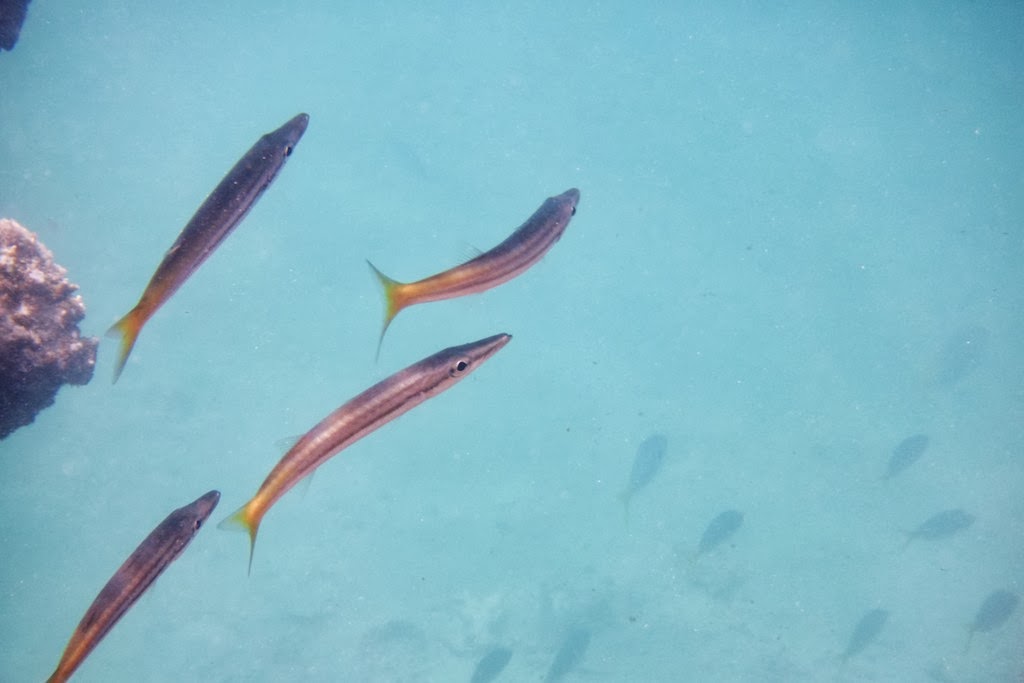 |
| Pearl Bay |
Good winds were forecasted to get us there, however, they turned out to be just a little bit too good.
Our first stop was at Pearl Bay, which is just a little north of Port Clinton where we stayed a few blogs back. Pearl Bay is also a part of the large Shoalwater Bay military exercise area.
We marvelled at our luck of having huge expanses of tropical paradise to ourselves.
 |
| It's not as bad as it looks, it's worse! |
Nights were spent being flung from one side of the bunk to the other. I was grateful that I had melamine crockery as I lay there listening to it being smashed about in the cupboard.

Fresh water running from the backdrop of hills behind the beach created artwork in the sand.
The remains of a Painted Crayfish lay in the sand like a half finished piece of artwork.

We somehow managed to safely get to shore in our dinghy, where we strolled along the beach collecting sea shells.
When we had too many to carry we would put them in a neat little pile on the sand to collect on the way back. By the time we got back to them, we would decide that we didn't want to collect shells after all.
We did this quite a few times on our trip, leaving little middens of sea shell collections on deserted beaches.
From there we went to Scawfell Island which seemed to have quite a protected anchorage. We were getting a bit tired from lack of sleep in the rolly conditions here.
Although Scawfell had a protected anchorage, the large swells generated by the strong south-easterlies overcame all barriers and insisted we become desensitised to being thrown about. Boy, are we going to have our work cut out for us getting our land legs back after this.
Once again, we had this island to ourselves and we didn't even have to risk live bombs and lasers this time.
A surprise was in store for us when we went ashore as we found a picnic table and shelter with a rain water storage tank - FULL! We quickly went back to the boat and got our shampoo and returned for a much needed shower.
That afternoon, we decided to go snorkelling, even though it meant getting salty after our lovely fresh water shower.
The tide was low and the reef could be seen just below the surface. Ian took his spear gun and I took my camera so we could both shoot some fish.
Wow! We had been a bit disappointed with the reef in this area, and now we found some of the most amazing reef ever.
From a snorkeller's perspective, this was heaven. A myriad of coloured corals bloomed under the surface. decorated by living jewels of fish. Then suddenly the reef dropped into sudden depths of blue, with millions of fish securing the perimeter. There were deeps chasms and grottos interspersed throughout the reef with shafts of light dissecting the deeper blue depths of shadows.
No coral bleaching was apparent in this reef.
I felt like a kid let loose in a lolly shop.
Giant clams were in abundance. It is amazing at the different colours theses come in.
 The reef ended abruptly and fell into the depths of blue.
The reef ended abruptly and fell into the depths of blue.
We found these fish filter feeding at the surface of the water. These may have been the same as the fish we saw on our previous trip to the Top End at 7 Spirit Bay. I took about 200 photos which I managed to edit down to 4 photos. I'll only make you look at two of them :)
I had to make a movie of my underwater exploits. If you want to watch it, it uses *62mb and goes for 1:41secs - I've upgraded the resolution on the movie from my original blog.
If you want to know how the Great White Hunter went with his shooting, yes, he was successful. He managed to spear a large parrot fish which looked much too beautiful to eat (that's why I won't show you the photo). Grant's Fish Guide said they were good eating, we were dubious till we tasted. Yum! However, we reserved the thumbs up till the next day after we found that we didn't get sick.
After consulting the weather charts on the B.O.M site, we are a bit worried about a low sitting to the north east of Cape York, so we'll wait around in safe areas a while before venturing north again.








































